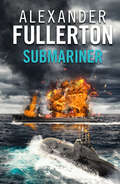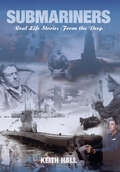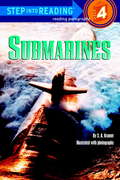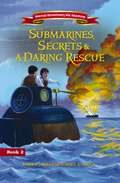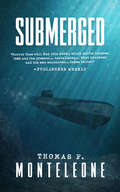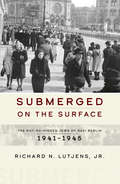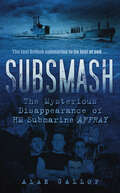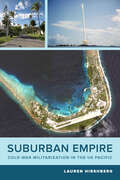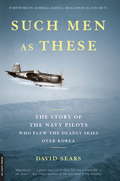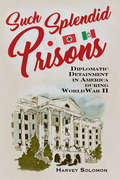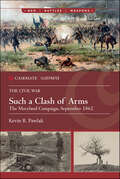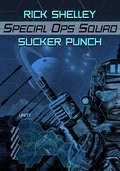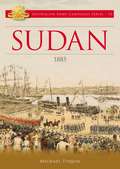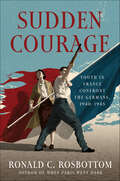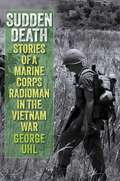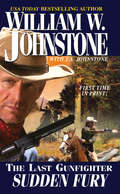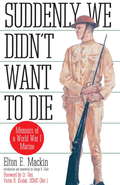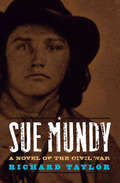- Table View
- List View
Submariner
by Alexander FullertonAnother epic Second World War adventure from the author of the Nicholas Everard naval thrillers.As captain of the submarine Ursa, Lieutenant Mike Nicholson’s mission is to disrupt the flow of war supplies to Rommel’s Afrika Korps. Although Ursa is small, slow and often out-gunned, she succeeds, on her seventeenth Mediterranean cruise, in sinking a German tank-transporter.That triumph makes Mike top of the league – he has now sunk more tonnage than any of his contemporaries. Promotion to Lieutenant-Commander, at the age of twenty-eight, is on the cards. All he has to do is adhere to two rules: stay alive, and keep his nose clean…Submariner is a gripping Second World War naval thriller that will appeal to fans of Douglas Reeman and Jack Higgins.
Submariners: Real Life Stories from the Deep
by Keith HallThe Senior Service has, for a hundred years, had submarines. Originally thought to be Un-English, submarines helped us win two World Wars and have played a great part in Britain's nuclear deterrent for the past thirty years.
Submarines (Step into Reading)
by Sydelle KramerYoung readers are in for the most exciting trip of their lives as they venture into a nuclear submarine! While touring the vessel from bow to stern, they learn about the history and mechanics of subs, their military and scientific uses, and the incredible discomfort-and danger-of life onboard. Illustrated with photographs, this is easy-to-read, high-interest nonfiction at its most compelling!
Submarines under Ice: The U.S. Navy's Polar Operations
by Marion D. WilliamsThe author beautifully depicts the 1931 submarine expedition of Sir Hubert Wilkins to explore the Arctic Ocean. The book also shows the rapid advance of science and technology in submarines.
Submarines, Secrets and a Daring Rescue (American Revolutionary War Adventures #2)
by Robert J. SkeadTwins John and Ambrose Clark find themselves aiding the patriots once again as they help work on a top-secret submarine that could end the war … and also look for a way to rescue their captured older brother. Based on the real Bushnell's Turtle, book two of the American Revolutionary War Adventures historical fiction series is a fun way for children to experience American history.After working as spies to aid the Colonies and delivering a message to General George Washington himself, twins Ambrose and John Clark find themselves volunteering for another mission to help the newly forming United States. This time, the boys step up to help transport much-needed gunpowder to the patriots, and end up in an even more dangerous situation—trying to man one of the first submarines. But the biggest challenge may be finding a way to free their imprisoned older brother.In addition to bringing to life America's war for independence, including information on the first submarine built in America, Submarines, Secrets, and a Daring Rescue:Teaches children about the Revolutionary War from a kid's perspectiveIs packed with historical information that is entertaining and educationalContains discussion questions, backgrounds on the real-life historical persons featured in the book, historical letters, and a glossary of key termsCan be used alongside school curriculum and as a homeschool resourceAmerican Revolutionary War Adventures:Are great for young readers ages 8-12 who like historyAre a fictionalized stories from history inspired by real events and peopleAre perfect for back to school or summer reading challengesMake a great gift for Christmas, holidays, birthdays, or other gift-giving occasions
Submerged
by Thomas F. Monteleone&“An epic thriller about a secret Nazi submarine and its mission . . . a tasty combination of Ken Follett and Clive Cussler&” from the award-winning author (The Novel Pursuit). Cruising from the sub pens of Trondheim under the cover of darkness—undetected by the sonar scans of Allied enemies—Kapitaenleutnant Erich Heinz Bruckner leads the experimental submarine U-5001 in a last-ditch effort for Nazi victory. But their sinister 1945 voyage ends mysteriously: Bruckner and his crew vanish, along with their classified weapon of mass destruction. Seventy years later, ex-Navy diver Dexter Bucklin stumbles upon an unknown vessel in the depths of the Chesapeake Bay and is consumed with the need to discover its original, terrifying mission—inadvertently alerting a worldwide cabal that knows all about the U-5001 . . . and the keys it holds to even greater secrets. A thriller in the tradition of Ken Follett and Robert Ludlum, Submerged follows both Bruckner and Bucklin in a narrative that spans generations of adventure and horror—Lovecraftian tales at their most strange. As these men&’s lives converge, a third element surfaces, influencing the Kapitaenleutnant and the ex-Navy diver to make increasingly desperate decisions, ones that will shape the future of civilization. Thomas F. Monteleone expertly blends history, fact, and fiction with a subtle dose of the supernatural in this Lovecraftian page-turner. Praise for Thomas F. Monteleone &“Monteleone has a dark imagination, a wicked pen, and the rare ability to convey an evil chill with words.&” —Dean Koontz, New York Times–bestselling author &“Tom&’s an expert storyteller.&” —F. Paul Wilson, author of The Keep and Deep as the Marrow &“A vastly entertaining novel of horror and suspense [that poses] difficult questions about the nature of man, God and the devil.&” —Los Angeles Daily News
Submerged on the Surface: The Not-So-Hidden Jews of Nazi Berlin, 1941–1945
by Richard LutjensBetween 1941 and 1945, thousands of German Jews, in fear for their lives, made the choice to flee their impending deportations and live submerged in the shadows of the Nazi capital. Drawing on a wealth of archival evidence and interviews with survivors, this book reconstructs the daily lives of Jews who stayed in Berlin during the war years. Contrary to the received wisdom that “hidden” Jews stayed in attics and cellars and had minimal contact with the outside world, the author reveals a cohort of remarkable individuals who were constantly on the move and actively fought to ensure their own survival.
Subsmash: The Mysterious Disappearance of HM Submarine Affray
by Alan GallopIn April 1951, the disappearance of HM submarine Affray knocked news of the Korean War and Festival of Britain from the front pages. Affray had put to sea on a routine peacetime simulated war patrol in the English Channel. She radioed her last position at 2115hrs on 16 April, 30 miles south of the Isle of Wight - preparing to dive. This was the last signal ever received from the submarine. After months of searching, divers eventually discovered Affray resting upright on the sea bottom with no obvious signs of damage to her hull. Hatches were closed tight and emergency buoys were still in their casings. It was obvious that whatever had caused Affray to sink, and had ended the lives of all those on board, had occurred quickly. Sixty years later, in this compelling maritime investigation, Alan Gallop uses previously top secret documents, interviews with experts and contemporary news sources to explore how and why Affray became the last British submarine lost at sea - and possibly the greatest maritime mystery since the Marie Celeste.
Substance Use Disorders In The U.S. Armed Forces
by Committee on Prevention Treatment Diagnosis Management of Substance Use Disorders in the U.S. Armed ForcesProblems stemming from the misuse and abuse of alcohol and other drugs are by no means a new phenomenon, although the face of the issues has changed in recent years. National trends indicate substantial increases in the abuse of prescription medications. These increases are particularly prominent within the military, a population that also continues to experience long-standing issues with alcohol abuse. The problem of substance abuse within the military has come under new scrutiny in the context of the two concurrent wars in which the United States has been engaged during the past decade--in Afghanistan (Operation Enduring Freedom) and Iraq (Operation Iraqi Freedom and Operation New Dawn). Increasing rates of alcohol and other drug misuse adversely affect military readiness, family readiness, and safety, thereby posing a significant public health problem for the Department of Defense (DoD). To better understand this problem, DoD requested that the Institute of Medicine (IOM) assess the adequacy of current protocols in place across DoD and the different branches of the military pertaining to the prevention, screening, diagnosis, and treatment of substance use disorders (SUDs). Substance Use Disorders in the U. S. Armed Forces reviews the IOM's task of assessing access to SUD care for service members, members of the National Guard and Reserves, and military dependents, as well as the education and credentialing of SUD care providers, and offers specific recommendations to DoD on where and how improvements in these areas could be made.
Subsunk
by W. O. ShelfordFrom the book: The dread signal cuts through the ether like a knife. No code clerk need spell out its meaning it is the signal of disaster. Somewhere a sub is down, men are trapped far below the ocean's surface, time is running out... This is an absorbing drama of submarine escape. Crammed with stories of horror and despair, of incredible fortitude and courage, it reflects the supreme dedication of the men who brave the hazards of the silent service.
Suburban Empire: Cold War Militarization in the US Pacific (American Crossroads #64)
by Lauren HirshbergSuburban Empire takes readers to the US missile base at Kwajalein Atoll in the Marshall Islands, at the matrix of postwar US imperial expansion, the Cold War nuclear arms race, and the tide of anti-colonial struggles rippling across the world. Hirshberg shows that the displacement of indigenous Marshallese within Kwajalein Atoll mirrors the segregation and spatial politics of the mainland US as local and global iterations of US empire took hold. Tracing how Marshall Islanders navigated US military control over their lands, Suburban Empire reveals that Cold War–era suburbanization was perfectly congruent with US colonization, military testing, and nuclear fallout. The structures of suburban segregation cloaked the destructive history of control and militarism under a veil of small-town innocence.
Successful Strategies
by Williamson Murray Richard Hart SinnreichSuccessful Strategies is a fascinating new study of the key factors that have contributed to the development and execution of successful strategies throughout history. With a team of leading historians, Williamson Murray and Richard Hart Sinnreich examine how, and to what effect states, individuals and military organizations have found a solution to complex and seemingly insoluble strategic problems to reach success. Bringing together grand, political and military strategy, the book features thirteen essays which each explores a unique case or aspect of strategy. The focus ranges from individuals such as Themistocles, Bismarck and Roosevelt to organizations and bureaucratic responses. Whether discussing grand strategy in peacetime or that of war or politics, these case studies are unified by their common goal of identifying in each case the key factors that contributed to success as well as providing insights essential to any understanding of the strategic challenges of the future.
Such Men as These: The Story of the Navy Pilots Who Flew the Deadly Skies over Korea
by David SearsIn 1951, James Michener went to Korea to report on a little known aspect of America's stalemated war: navy aviators. His research inspired novel about these pilots became an overnight bestseller and, perhaps, the most widely read book ever written about aerial combat.Using Michener's notes, author David Sears tracked down the actual pilots to tell their riveting, true-life stories. From the icy, windswept decks of aircraft carriers, they penetrated treacherous mountain terrain to strike heavily defended dams, bridges, and tunnels, where well entrenched Communist anti-aircraft gunners waited to shoot them down. Many of these men became air combat legends, and one, Neil Armstrong, the first astronaut to walk on the moon.Such Men As These brims with action-packed accounts of combat and unforgettable portraits of the pilots whose skill and sacrifice made epic history.
Such Splendid Prisons: Diplomatic Detainment in America during World War II
by Harvey SolomonIn the chaotic days after the bombing of Pearl Harbor, the Roosevelt administration made a dubious decision affecting hundreds of Axis diplomats remaining in the nation&’s capital. To encourage reciprocal treatment of U.S. diplomats trapped abroad, Roosevelt sent Axis diplomats to remote luxury hotels—a move that enraged Americans stunned by the attack. This cause célèbre drove a fascinating yet forgotten story: the roundup, detention, and eventual repatriation of more than a thousand German, Japanese, Italian, Bulgarian, and Hungarian diplomats, families, staff, servants, journalists, students, businessmen, and spies.Such Splendid Prisons follows five of these internees whose privileged worlds came crashing down after December 7, 1941: a suave, calculating Nazi ambassador and his charming but conflicted wife; a wily veteran Japanese journalist; a beleaguered American wife of a Japanese spy posing as a diplomat; and a spirited but naive college-aged daughter of a German military attaché. The close, albeit luxurious, proximity in which these Axis power emissaries were forced to live with each other stripped away the veneer of false prewar diplomatic bonhomie. Conflicts ran deep not only among the captives but also among the rival U.S. agencies overseeing a detainment fraught with uncertainty, duplicity, lust, and romance. Harvey Solomon re-creates this wartime American period of deluxe detention, public outrage, hidden agendas, rancor and racism, and political machinations in a fascinating but forgotten story.
Such Sweet Sorrow
by Catrin CollierHave you ever wondered what it would be like to work for yourself? Since the recent recession figures show that more and more people, both young and old, would rather set up their own business than continue searching for jobs that are scarce, and often end up being poorly-paid. In Be Your Own Boss, dozens of ordinary people who have taken the plunge and launched their own successful businesses, share their know-how on how to get started and on the common mistakes to avoid. Whether it's baking cakes to make a bit of spare cash, leaving school at 16 to launch a magazine, turning redundancy into an opportunity or attracting money from the stars of TV's Dragons' Den, their stories will inspire. Business experts also share their top tips on where to go for money and advice to take your ideas from the bedroom to the boardroom. This book has all you need to start on the journey to be your own boss.
Such Troops as These
by Bevin AlexanderAcclaimed military historian Bevin Alexander offers a fresh and cogent analysis of Stonewall Jackson's military genius and reveals how the Civil War might have ended differently if Jackson's strategies had been adopted. The Civil War of 1861-65 pitted the industrial North against the agricultural South, and remains the most catastrophic conflict in terms of loss of life in American history. With triple the population and eleven times the industry, the Union had a decided advantage over the Confederacy in terms of direct conflict and conventional warfare. One general had the vision of an alternative approach that could win the War for the South--his name was Thomas J. "Stonewall" Jackson. It was Jackson's strategy to always strike at the Union's vulnerabilities, not to challenge its power directly. He won a campaign against the North with a force only a quarter of the size of the Union army, and he was the first commander to recognize the overwhelming defensive power of the new rifles and cannons. With most of its military forces on the offensive in the South, the North was left virtually undefended on its own turf. Jackson believed invading the eastern states along the great industrial corridor from Baltimore to Maine could divide and cripple the Union, forcing surrender. But he failed to convince Confederate president Jefferson Davis or General Robert E. Lee of the viability of his plan. In Such Troops as These, Bevin Alexander presents a compelling case for Stonewall Jackson as a supreme military strategist and the greatest general in American history. Fiercely dedicated to the cause of Southern independence, Jackson would not live to see the end of the War. But his military legacy lives on and finds fitting tribute in this book.
Such a Clash of Arms: The Maryland Campaign, September 1862 (Casemate Illustrated)
by Kevin R. PawlakA fully illustrated narrative of the Maryland campaign 1862, culminating in Antietam, the bloodiest single day in American military history. By the late summer of 1862, it appeared as though the United States would be permanently split in two, and by the beginning of September, General Robert E. Lee's Army of Northern Virginia was on the doorstep of Washington, D.C. Panicked and defeated Federal soldiers huddled behind the capital’s defenses. Rather than attacking the city, Lee turned his attention north into Maryland, seeking a decisive battlefield victory to influence public opinion at home and diplomatic opinion overseas. Major General George B. McClellan led the reorganized Army of the Potomac into the state to meet Lee. Over a span of 18 days, the two armies fought four significant battles, including the climactic engagement along Antietam Creek outside Sharpsburg on September 17, 1862. The battle there still holds the distinction as the bloodiest single day in American military history. Forced from Maryland, Lee withdrew into Virginia, leaving President Abraham Lincoln free to follow up this strategic victory with the preliminary Emancipation Proclamation, a measure that changed the nature of the American Civil War. Copious illustrations and maps paired with a detailed text, this account of the Maryland campaign will have wide appeal.
Sucker Punch: Sucker Punch (Special Ops Squad #3)
by Rick ShelleyThe Spec Ops Squad is a group of elite soldiers from every alien race in the Alliance of Light. They're supposed to be the best of the best. It's been tough to forge them into a team; they didn't have much in common at the beginning. But commanding officer Sergeant Bart "Dragon" Drak has done a good job, and the Squad has achieved some important victories--at a heavy cost.Now they're facing their toughest test yet. The Alliance of Light has built a utopian community on the planet Unity, where people from all the various alien races live together. But Unity is threatened by an attack from the Ilion Federation. The Spec Ops Squad and the rest of their regiment are responsible for holding Ilion at bay until the Alliance can build up their supports. The Squad is up for the task. The only question is, can Unity hold itself together long enough?PRAISE FOR THE AUTHOR:"Rick Shelley was a soldier at heart, and his books were written from the heart. They carry the real feel of the sweat, blood, and camaraderie of those on the front lines." --Jack Campbell, author of the bestselling Lost Fleet series
Sudan: 1885 (Australian Army Campaigns #15)
by Michael TyquinThe involvement of an Australian colonial military force in Britain's Egyptian campaigns between 1883 and 1885 was very short, extending for only five months overall, including the pre-deployment phase. Consequently its influence on these campaigns was insignificant. Nevertheless, our involvement in the Sudan in 1885 is part of Australia’s military history. This book provides the context for Australia’s involvement in the Sudan, and follows operations chronologically. The call in the 1880s for jihad or ‘holy war’ by Sudanese leaders shows us that some of our current global challenges are not new.
Sudden Courage: Youth in France Confront the Germans, 1940–1945
by Ronald C. RosbottomThe author of When Paris Went Dark returns to World War II to tell the remarkable story of the youngest members of the French Resistance and their war against the German occupiers and their collaboratorsOn June 14, 1940, German tanks entered a nearly deserted Paris. Eight days later, France accepted a humiliating defeat and foreign occupation. Many adapted to the situation—even allied themselves with their new overlords. Yet amid increasing Nazi ruthlessness, shortages and arbitrary curfews, a resistance arose—a shadow army of workers, intellectuals, shop owners, police officers, Jews, immigrants, and communists. Among this army were a remarkable number of adolescents and young men and women; it was estimated by one underground leader that “four-fifths of the members of the resistance were under the age of thirty.” Months earlier, they would have been spending their evenings studying for exams, sneaking out to dates, and finding their footing at first jobs. Now they learned the art of sabotage, the ways of disguise and deception, how to stealthily avoid patrols, steal secrets, and eliminate the enemy—sometimes violently.Nevertheless, in most histories of the French Resistance, the substantial contributions of the young have been minimized or, at worst, ignored. Sudden Courage remedies that amnesia. Amid heart-stopping accounts of subterfuge, narrow escapes, and deadly consequences, we meet blind Jacques Lusseyran, who created one of the most influential underground networks in Paris; Guy Môquet, whose execution at the hands of Germans became a cornerstone of rebellion; Maroussia Naïtchenko, a young communist uncannily adept at escaping Gestapo traps; André Kirschen, who at fifteen had to become an assassin; Anise Postel-Vinay, captured and sent to a concentration camp; and bands of other young rebels who chose to risk their lives for a better tomorrow. But Sudden Courage is more than an inspiring account of youthful daring and determination. It is also a riveting investigation of what it means to come of age under the threat of rising nativism and authoritarianism—one with a deep bearing on our own time.
Sudden Death: Stories of a Marine Corps Radioman in the Vietnam War
by George UhlThrough the eyes of a Marine radioman, Sudden Death unveils the constant threat of death in Vietnam&’s unforgiving jungles.His call sign said it all: Sudden Death. It didn&’t take George Uhl long into his tour to learn that in Vietnam death could be lurking behind the next tree, in the next rice paddy, on the next patrol, on his very next step down a damp jungle path. From April 1966 to May 1967, the Marine radioman was in the thick of things, and in this unforgettable memoir, he vividly describes his tour in Southeast Asia, recounting the sleepless nights, the scorching days, and the terrifying minutes that seemed like days, and remembering the thoughts and fears of a young man fighting a war—and trying to stay alive—thousands of miles from home.
Sudden Fury: Sudden Fury (The Last Gunfighter #20)
by William W. Johnstone J.A. JohnstoneThe famous gunfighter come face to face with a deadly legend of another kind in this action-packed western by the New York Times–bestselling author.Deep in the forests of Northern California, something is killing humans like an animal. The loggers call it &“The Terror of the Redwoods.&” A local timber baron has put a bounty on the hide of this man-beast, and the woods are teeming with so many trigger-happy dolts and half-cocked drunkards that someone's bound to get hurt—and bad.Frank Morgan doesn't believe in such creatures and decides to get to the bottom of this tall tale. But when he meets the timber baron's beautiful daughter, all bets are off. Something is out there. Someone's set a trap. And Morgan just stuck his Bigfoot right into it.
Sudden Terror: Exposing Militant Islam's War Against the United States and Israel
by David FriedmanSeptember 11, 2001: A day that changed the world. No longer do Americans have the luxury of assuming that because we are halfway across the globe from nations that incite terrorism, we are immune to danger. We have now experienced what Israel has been living with for decades. "Sudden Terror" exposes the hidden agenda of militant Islam. You will learn why both the United States and Israel are targets of this radical scheme, what nations that give rise to terrorism are teaching their children, and what is being printed in their newspapers and broadcast over their airwaves. The author, a former member of the Israel Defense Forces, provides eye-opening answers to these and other critical questions.
Suddenly We Didn't Want To Die: Memoirs of a World War I Marine
by Elton E. MackinMackin's memoirs are a haunting portrayal of war in the tradition of All Quiet on the Western Front.
Sue Mundy: A Novel of the Civil War (Kentucky Voices)
by Richard TaylorA teenage boy fighting in the American Civil War becomes a Kentucky legend in this historical novel by the author of Girty and Elkhorn.October 11, 1864. The Civil War rages on in Kentucky, where Union and Confederate loyalties have turned neighbors into enemies and once-proud soldiers into drifters, thieves, and outlaws. Stephen Gano Burbridge, radical Republican and military commander of the district of Kentucky, has declared his own war on this new class of marauding guerrillas, and his weekly executions at Louisville’s public commons draw both crowds and widespread criticism.In this time of fear and division, a Kentucky journalist created a legend: Sue Mundy, female guerrilla, a “she-devil” and “tigress” who was leading her band of outlaws across the state in an orgy of greed and bloodshed. Though the “Sue Mundy” of the papers was created as an affront to embarrass Union authorities, the man behind the woman—twenty-year-old Marcellus Jerome Clarke—was later brought to account for “her” crimes. Historians have pieced together clues about this orphan from southern Kentucky whose idealism and later disillusionment led him to his fate, but Richard Taylor’s work of imagination makes this history flesh—an exciting story of the Civil War told from the perspective of one of its most enigmatic figures.Sue Mundy opens in 1861, when fifteen-year-old Jerome Clark, called “Jarom,” leaves everyone he loves—his aunt, his adopted family, his sweetheart—to follow his older cousin into the Confederate infantry. There, confronted by the hardships of what he slowly understands is a losing fight, Jarom’s romanticized notions of adventure and heroism are crushed under the burdens of hunger, sleepless nights, and mindless atrocities. Captured by Union forces and imprisoned in Camp Morton, Jarom makes a daring escape, crossing the Ohio River under cover of darkness and finding refuge and refreshed patriotic zeal first in Adam R. Johnson’s Tenth Kentucky Calvary, then among General John Hunt Morgan’s infamous brigade. Morgan’s shocking death in 1864 proves a bad omen for the Confederate cause, as members of his group of raiders scatter—some to rejoin organized forces, others, like Jarom, to opt for another, less civilized sort of warfare. Displaced and desperate for revenge, Jarom and his band of Confederate deserters wreak havoc in Kentucky: a rampage of senseless murder and thievery in an uncertain quest to inflict punishment on Union sympathizers. Long-locked and clean-shaven, Jarom is mistakenly labeled female by the media—but Sue Mundy is about more than the transformation of a man into a woman, and then a legend. Ironically, Sue Mundy becomes the persona by which Jarom’s darkest self is revealed, and perhaps redeemed.Praise for Sue Mundy“Fans of the Civil War and historical military fiction will appreciate the author’s depiction of war in a border state.” —Publishers Weekly“Taylor’s gift here is to bring history alive. His writing has always been informed by a deep love and affinity for history?his poetry and his fiction?particularly as it relates to the present.” —Louisville Courier-Journal
